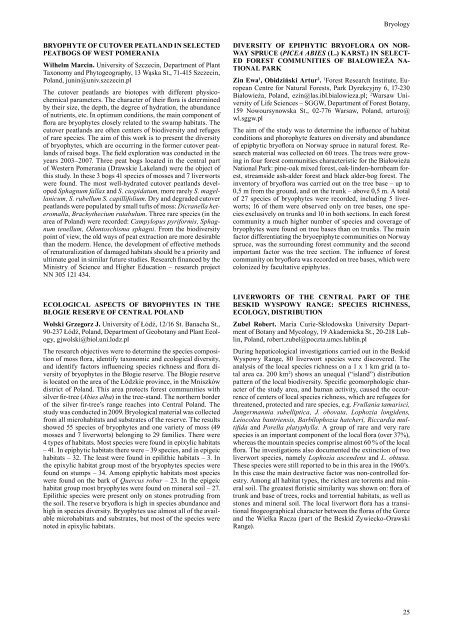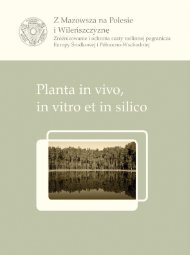acta societatis botanicorum poloniae - LV Zjazd Polskiego ...
acta societatis botanicorum poloniae - LV Zjazd Polskiego ...
acta societatis botanicorum poloniae - LV Zjazd Polskiego ...
Create successful ePaper yourself
Turn your PDF publications into a flip-book with our unique Google optimized e-Paper software.
BrYOPHYTE OF CUTOVEr PEATLANd IN SELECTEd<br />
PEATBOGS OF WEST POMErANIA<br />
Wilhelm Marcin. University of Szczecin, Department of Plant<br />
Taxonomy and Phytogeography, 13 Wąska St., 71-415 Szczecin,<br />
Poland, junin@univ.szczecin.pl<br />
The cutover peatlands are biotopes with different physicochemical<br />
parameters. The character of their flora is determined<br />
by their size, the depth, the degree of hydration, the abundance<br />
of nutrients, etc. In optimum conditions, the main component of<br />
flora are bryophytes closely related to the swamp habitats. The<br />
cutover peatlands are often centers of biodiversity and refuges<br />
of rare species. The aim of this work is to present the diversity<br />
of bryophytes, which are occurring in the former cutover peatlands<br />
of raised bogs. The field exploration was conducted in the<br />
years 2003– 2007. Three peat bogs located in the central part<br />
of Western Pomerania (Drawskie Lakeland) were the object of<br />
this study. In these 3 bogs 41 species of mosses and 7 liverworts<br />
were found. The most well-hydrated cutover peatlands developed<br />
Sphagnum fallax and S. cuspidatum, more rarely S. magellanicum,<br />
S. rubellum S. capillifolium. Dry and degraded cutover<br />
peatlands were populated by small tufts of moss: Dicranella heteromalla,<br />
Brachythecium rutabulum. Three rare species (in the<br />
area of Poland) were recorded: Campylopus pyriformis, Sphagnum<br />
tenellum, Odontoschisma sphagni. From the biodiversity<br />
point of view, the old ways of peat extraction are more desirable<br />
than the modern. Hence, the development of effective methods<br />
of renaturalization of damaged habitats should be a priority and<br />
ultimate goal in similar future studies. Research financed by the<br />
Ministry of Science and Higher Education – research project<br />
NN 305 121 434.<br />
ECOLOGICAL ASPECTS OF BrYOPHYTES IN THE<br />
BŁoGIE RESERvE of CENtRAL PoLAND<br />
Wolski Grzegorz J. University of Łódź, 12/16 St. Banacha St.,<br />
90-237 Łódź, Poland, Department of Geobotany and Plant Ecology,<br />
gjwolski@biol.uni.lodz.pl<br />
The research objectives were to determine the species composition<br />
of moss flora, identify taxonomic and ecological diversity,<br />
and identify factors influencing species richness and flora diversity<br />
of bryophytes in the Błogie reserve. The Błogie reserve<br />
is located on the area of the Łódzkie province, in the Mniszków<br />
district of Poland. This area protects forest communities with<br />
silver fir-tree (Abies alba) in the tree-stand. The northern border<br />
of the silver fir-tree’s range reaches into Central Poland. The<br />
study was conducted in 2009. Bryological material was collected<br />
from all microhabitats and substrates of the reserve. The results<br />
showed 55 species of bryophytes and one variety of moss (49<br />
mosses and 7 liverworts) belonging to 29 families. There were<br />
4 types of habitats. Most species were found in epixylic habitats<br />
– 41. In epiphytic habitats there were – 39 species, and in epigeic<br />
habitats – 32. The least were found in epilithic habitats – 3. In<br />
the epixylic habitat group most of the bryophytes species were<br />
found on stumps – 34. Among epiphytic habitats most species<br />
were found on the bark of Quercus robur – 23. In the epigeic<br />
habitat group most bryophytes were found on mineral soil – 27.<br />
Epilithic species were present only on stones protruding from<br />
the soil. The reserve bryoflora is high in species abundance and<br />
high in species diversity. Bryophytes use almost all of the available<br />
microhabitats and substrates, but most of the species were<br />
noted in epixylic habitats.<br />
Bryology<br />
dIVErSITY OF EPIPHYTIC BrYOFLOrA ON NOr-<br />
WAY SPrUCE (PiceA Abies (L.) KArST.) IN SELECT-<br />
ED foRESt CoMMUNItIES of BIAŁoWIEżA NA-<br />
TIONAL PArK<br />
Zin Ewa1 , obidziński Artur2 . 1Forest Research Institute, European<br />
Centre for Natural Forests, Park Dyrekcyjny 6, 17-230<br />
Białowieża, Poland, ezin@las.ibl.bialowieza.pl; 2Warsaw University<br />
of Life Sciences – SGGW, Department of Forest Botany,<br />
159 Nowoursynowska St., 02-776 Warsaw, Poland, arturo@<br />
wl.sggw.pl<br />
The aim of the study was to determine the influence of habitat<br />
conditions and phorophyte features on diversity and abundance<br />
of epiphytic bryoflora on Norway spruce in natural forest. Research<br />
material was collected on 60 trees. The trees were growing<br />
in four forest communities characteristic for the Białowieża<br />
National Park: pine-oak mixed forest, oak-linden-hornbeam forest,<br />
streamside ash-alder forest and black alder-bog forest. The<br />
inventory of bryoflora was carried out on the tree base – up to<br />
0,5 m from the ground, and on the trunk – above 0,5 m. A total<br />
of 27 species of bryophytes were recorded, including 5 liverworts;<br />
16 of them were observed only on tree bases, one species<br />
exclusively on trunks and 10 in both sections. In each forest<br />
community a much higher number of species and coverage of<br />
bryophytes were found on tree bases than on trunks. The main<br />
factor differentiating the bryoepiphyte communities on Norway<br />
spruce, was the surrounding forest community and the second<br />
important factor was the tree section. The influence of forest<br />
community on bryoflora was recorded on tree bases, which were<br />
colonized by facultative epiphytes.<br />
LIVErWOrTS OF THE CENTrAL PArT OF THE<br />
BESKId WYSPOWY rANGE: SPECIES rICHNESS,<br />
ECOLOGY, dISTrIBUTION<br />
Zubel robert. Maria Curie-Skłodowska University Department<br />
of Botany and Mycology, 19 Akademicka St., 20-218 Lublin,<br />
Poland, robert.zubel@poczta.umcs.lublin.pl<br />
During hepaticological investigations carried out in the Beskid<br />
Wyspowy Range, 80 liverwort species were discovered. The<br />
analysis of the local species richness on a 1 x 1 km grid (a total<br />
area ca. 200 km 2 ) shows an unequal (“island”) distribution<br />
pattern of the local biodiversity. Specific geomorphologic character<br />
of the study area, and human activity, caused the occurrence<br />
of centers of local species richness, which are refugees for<br />
threatened, protected and rare species, e.g. Frullania tamarisci,<br />
Jungermannia subelliptica, J. obovata, Lophozia longidens,<br />
Leiocolea bantriensis, Barbilophozia hatcheri, Riccardia multifida<br />
and Porella platyphylla. A group of rare and very rare<br />
species is an important component of the local flora (over 37%),<br />
whereas the mountain species comprise almost 60 % of the local<br />
flora. The investigations also documented the extinction of two<br />
liverwort species, namely Lophozia ascendens and L. obtusa.<br />
These species were still reported to be in this area in the 1960’s.<br />
In this case the main destructive factor was non-controlled forestry.<br />
Among all habitat types, the richest are torrents and mineral<br />
soil. The greatest floristic similarity was shown on: flora of<br />
trunk and base of trees, rocks and torrential habitats, as well as<br />
stones and mineral soil. The local liverwort flora has a transitional<br />
fitogeographical character between the floras of the Gorce<br />
and the Wielka Racza (part of the Beskid Żywiecko-Orawski<br />
Range).<br />
25



